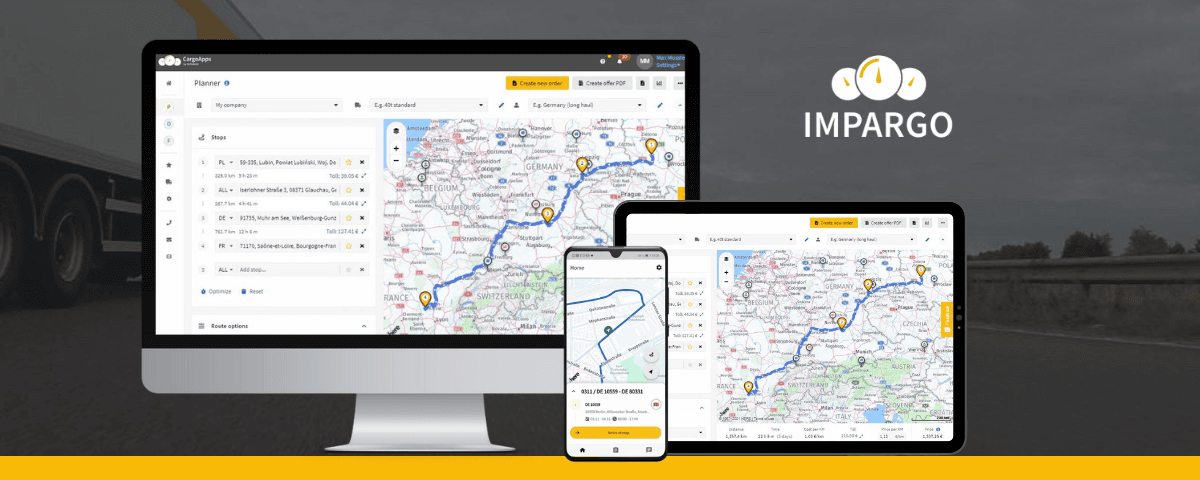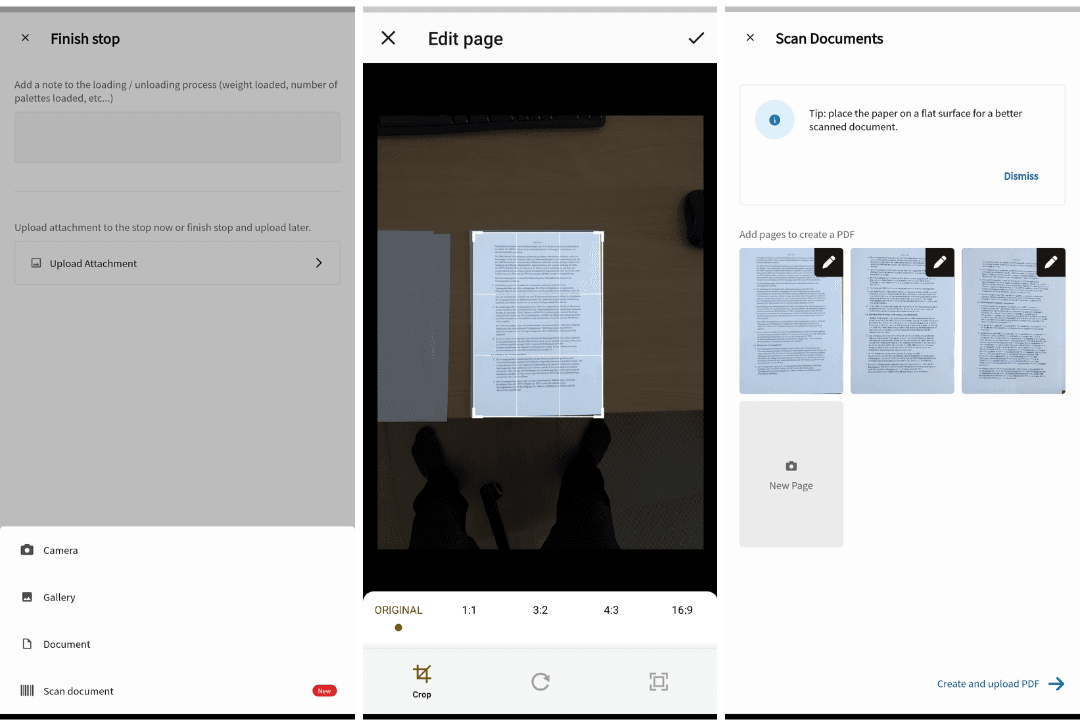Introduction
Proof of Delivery (POD) and Bill of Lading (BOL) are two essential documents used in LTL (Less Than Truckload) shipping. The exchange of important documents such as the Bill of Lading (BOL) and Proof of Delivery (POD) is crucial for successful logistics operations.
In this blog post, we'll explore the meanings of Bill of Lading and Proof of Delivery, delve into Bill of Lading tracking aspects, provide a practical example of a Bill of Lading, and introduce IMPARGO's dispatch software solution, the DriverApp.
Table of Content
- Bill of Lading (BOL) Meaning
- Proof of Delivery (POD) Meaning
- Digital POD Tracking (Digital Bill of Lading Tracking)
- How to Send Bill of Lading (BOL) or Proof of Delivery (POD) Online
- Proof of Delivery (POD) Example Template
- Bill of Lading (BOL) Example Template
- Role of the Bill of Lading (BOL) Form
- Types of Bill of Lading Forms
Bill of Lading (BOL) Meaning
The Bill of Lading is a critical document in the shipping industry. It serves as a receipt of goods shipped, a document of title, and a contract between the shipper and the carrier.
The BOL outlines the details of the shipment, including the type and quantity of goods, destination, and terms of transportation.
The necessary elements that should be included in a Bill of Lading are as follows:
A. Parties Involved: The bill should clearly mention the parties involved in the process.
This includes:
Consignee: The person or entity to whom the goods are being shipped.
Shipper: The person or entity who is shipping the goods.
Carrier: The entity that is responsible for transporting the goods and issuing the bill.
Payer of Freight: The party responsible for paying the freight charges.
Freight Forwarder: If applicable, the person or entity who arranges the transportation of the goods.
Arrival Agent: The agent or entity responsible for handling the shipment upon arrival at the destination.
B. Cargo Details: The bill should provide specific details about the cargo being shipped.
This includes:
Destination: The final destination where the goods are intended to be delivered.
Place of Delivery: The specific location where the cargo will be sent.
Route: The planned route or itinerary for transporting the goods to the destination.
Shipment Date: The date when the shipment is expected to be delivered or when it will be dispatched.
Transport Vehicle/Vessel: The type of vehicle or vessel that will be used to transport the cargo, such as a ship, truck, or airplane.
Including these necessary elements in the bill ensures clarity and transparency in the shipping process, and helps in accurately identifying the parties involved and the details of the cargo being transported.
Proof of Delivery (POD) Definition
The Proof of Delivery is a document that serves as evidence of the successful delivery of a shipment. It is typically created and signed by the receiver or consignee upon receiving the goods.
The POD includes important information such as:
Date and time of delivery: It specifies the exact date and time when the shipment was delivered.
Name and signature of the receiver: The person who receives the shipment acknowledges the delivery by signing the document.
Description of items delivered: It includes details about the items received, such as quantity or any special instructions.
Condition of goods: The POD may note the condition of the goods upon delivery, including any damages or discrepancies.
The POD is crucial for the shipper, as it provides proof that the goods were successfully delivered to the intended recipient. It safeguards against disputes regarding non-delivery and serves as documentation for payment and customer service purposes.

Digital POD Tracking (Digital Bill of Lading Tracking)
Bill of Lading Tracking (or POD Tracking) allows stakeholders to monitor the status and location of their shipments in real-time.
Digital Document Tracking offers several advantages:
1. Faster processing: Real-time transmission of data speeds up delivery processing, resulting in quicker delivery times and improved efficiency.
2. Improved accuracy: Digital systems reduce errors associated with paper-based methods, ensuring more reliable information.
3. Cost savings: By eliminating the need for printing, storage, and transportation of paper documents, digital POD / BOL reduces costs significantly.
4. Enhanced data management: Digital storage allows for easy access, retrieval, and integration with other business systems, improving overall operations.
5. Environmental sustainability: Going digital reduces paper usage, promoting environmentally friendly practices.
Overall, digital POD / BOL provides faster processing, improved accuracy, cost savings, efficient data management, and environmental sustainability.
How to Send Bill of Lading (BOL) or Proof of Delivery (POD) Online
IMPARGO's Dispatch Software Solution (DriverApp)

IMPARGO TMP® offers a cutting-edge dispatch software solution known as the DriverApp.
Collecting and digitizing documents from drivers and partners can be a hassle. That's why we've introduced a PDF Scanning feature within our DriverApp, tailored specifically for the convenience of your drivers.
The feature allows drivers to use their smartphone cameras to capture images of documents and instantly convert them to high-quality PDF files - all within a few taps. Here's what you can expect:
- Multi-Page PDFs: Compile multiple pages into a single, manageable PDF file.
- Simple editing for drivers: With a simple UI drivers can rotate, align, and crop the taken pictures to the standard DIN-A4 size for optimal clarity.
- Seamless integration: Every scanned document is automatically attached to the transport order within the CargoApps, simplifying record-keeping and tracking.
- Digitalised communication: Easily share the digital PODs with your clients via the tracking link.

This not only expedites the documentation process but also enhances overall visibility and collaboration within the supply chain.
How to Get Started?
- Update the IMPARGO DriverApp to the latest version on your iOS or Android device.
- When uploading an attachment or POD choose the new option “Scan document”.
- Take a picture of the pages you want to scan and crop them to the right size.
- Finally tap “Create and upload PDF” and the PDF is uploaded to the CargoApps.
Need Assistance?
Should you need any help with the new feature or have any questions, please don't hesitate to reach out to our support team.
Key features of IMPARGO's DriverApp include:
- Document Submission: Effortlessly send Bill of Lading and Proof of Delivery online.
- Real-time Tracking: Keep track of shipments in real-time, ensuring accurate and timely deliveries.
- Communication Hub: Enhance communication between shippers, carriers, and drivers for seamless coordination.
- User-Friendly Interface: The DriverApp is designed with user convenience in mind, making it easy for all stakeholders to navigate and utilize its features effectively.
IMPARGO TMP® 's DriverApp offers a comprehensive solution to simplify the dispatch process and elevate efficiency in the transportation of goods.
By tracking and sending essential documents like the Bill of Lading and Proof of Delivery online, businesses can not only save time and resources but also ensure a smoother and more transparent supply chain.
Proof of Delivery (POD) Example Template
```
[Carrier Name and Logo]
Proof of Delivery
Recipient Information:
Name: [Recipient's Name]
Address: [Recipient's Address]
Customer Order Details:
Order Number: [Order Number]
Items Ordered:
...
Transaction Mode: [Payment Method]
Delivery Information:
Date & Time of Delivery: [Delivery Date & Time]
Shipping Details: [Shipping Method]
Tracking Number: [Tracking Number]
Product Specifications:
Product: [Product Name]
Size: [Product Size]
Weight: [Product Weight]
Special Requirements: [Any Special Requirements]
Shipment Details:
Barcode/QR Code: [Barcode/QR Code]
Item Quantity: [Item Quantity]
Total Weight: [Total Weight]
Recipient Signature: ______________________
Date: ______________________
```
Please note that this is just an example template, and you may need to customize it according to your specific requirements and branding.
Bill of Lading (BOL) Example Template
Let's consider a simple and easy example of a Bill of Lading:
```
Bill of Lading
Shipper: ABC Manufacturing
Consignee: XYZ Retailers
Carrier: XYZ Logistics
Shipment Details:
- Description: Electronics
- Quantity: 100 units
- Weight: 500 kg
- Destination: City A
- Terms: FOB (Free On Board)
- Date of Shipment: [Date]
```
Disclaimer: This example illustrates the basic elements typically found in a Bill of Lading, providing a clear understanding of the document's structure.
Role of the Bill of Lading (BOL) Form
The three main roles and purposes of a Bill of Lading (BOL) are as follows:
1. Cargo Receipt: The primary use of a BOL is as a receipt for the cargo. Once the goods are loaded onto the vessel, the carrier issues the BOL. It serves as evidence of the shipment for insurance and customs purposes. It also acts as a commercial proof that the delivery contract has been completed. There are two scenarios where the BOL serves as a cargo receipt. Firstly, when the goods are delivered safely and the receiver confirms their satisfaction with the goods, the BOL can serve as a receipt. Secondly, if there is a discrepancy between the goods received and those described by the seller, the receiver can treat the BOL as a cargo receipt and claim for a "claused" BOL to reflect the discrepancy.
2. Contract Carriage: In addition to being a cargo receipt, the BOL can also serve as evidence of the contract of carriage. It is a contractual agreement between the carrier and the shipper, specifying the terms and conditions of transporting the freight. When the shipper and carrier enter into an agreement, it becomes the shipper's responsibility to deliver the goods to the carrier as discussed. In certain cases, the BOL is considered a bona fide document, meaning it is a definite proof and no contradictory evidence will be accepted.
3. Title Document: The BOL can also act as a document of title for the goods. When the buyer receives the goods from the carrier, the BOL serves as proof of ownership or title. There are two types of BOLs that can act as a title document. The first is an "order BOL" which is not issued in the name of a specific consignee and is negotiable. This means it can be transferred or negotiated to a third party. The second type is a "straight BOL" which is issued in the name of a specific consignee and is not negotiable. It is directed only to the named consignee and cannot be transferred to another party. In this way, the BOL identifies the consignee as the true and lawful holder, establishing their title to the goods.
These three roles and purposes of a Bill of Lading make it a crucial document in international trade and shipping, providing evidence of receipt, contractual obligations, and ownership of the goods.
Types of Bill of Lading Forms
Shipped Bill of Lading Meaning
This is a widely used document that serves as evidence of goods being shipped. In some cases, the shipper may require the ship owner to provide bills of lading that prove the goods have already been shipped. To ensure efficiency, these bill of lading forms are printed in advance. They typically state that the goods have been shipped in good condition, confirming their presence on board. Shippers often prefer this type of bill of lading due to its security, as it eliminates doubts about the goods being on board and facilitates early financial settlement.
Through Bill of Lading Meaning
Another commonly used but more complex type of bill of lading is the through bill of lading. This document allows the shipping carrier to transport cargo using various distribution centers and transportation methods. It enables the transportation of goods in both international freight shipments and domestic borders. The through bill of lading specifies the quantity and type of goods being transported and notifies the shipper of the destination. Since multiple modes of transportation can be used with this type of bill of lading, the transporter has flexibility in choosing the means of transportation and exporting the goods. It's worth noting that if you want to transport goods by sea, you will also need an ocean bill of lading.
Ocean Bill of Lading Meaning
The ocean bill of lading is a document required when transporting cargo across the sea, whether internationally or domestically. It serves as both a collection document and a carrier receipt for the shipper. The ocean bill of lading can be negotiable or non-negotiable. The non-negotiable version allows the buyer to receive the goods only upon presenting identification. On the other hand, the negotiable version requires the shipper to inspect the products and negotiate the conditions of the sale. This document enables shippers to ship goods overseas, but when land transportation is necessary, an inland bill of lading is required.
Inland Bill of Lading Meaning
Unlike the ocean bill of lading, the inland bill of lading is needed for goods that are transported over land. This document serves as both a carriage contract and a carrier's receipt. It includes information about the quantity, types, and destination of the goods. Goods transported over land can be moved by truck or rail. It's important to note that the inland bill of lading only covers transportation until the goods reach the shore, unlike the ocean bill of lading.
Received Bill of Lading Meaning
This type of bill of lading is signed by the receiver upon receiving the requested goods and materials. It confirms that the goods have been handed over to the ship owner and are now in their custody. The word "shipped" does not appear in this document, as the materials and cargo have already been sent and received by the party. After signing this document, the financial settlement is typically made through banks.
Claused Bill of Lading Meaning
The claused bill of lading is used when there is damage or a shortfall in the delivered goods, and it is filed by the receiver. This occurs when the shipped products do not meet the expected quality or quantity standards. The claused bill of lading, also known as a foul or dirty bill of lading, can create difficulties for exporters, as it may affect their payment and some banks may refuse to accept it. In such cases, purchasers may rely on letters of credit for payment.
Uniform Bill of Lading Meaning
The uniform bill of lading is an agreement between the carrier and exporter that outlines the details of the transported property. It provides essential information about the shipment, including the names of the recipient and shipper, the shipment's origin and destination, the transport time frame, the carrier's liability, insurance coverage in case of a claim, procedures for handling a foul shipment, and the disposition of the shipment if it is undelivered or refused.
Clean Bill of Lading Meaning
This document, issued by the carrier, confirms that the goods have been received by the exporter in good and satisfactory condition. It is the opposite of a claused or foul bill of lading. A clean bill of lading provides assurance to the exporter regarding payment and ensures that no payment will be withheld due to damaged or faulty products or delivery. Once the products have safely arrived without defects, the carrier will issue a clean bill of lading after thorough inspection.

